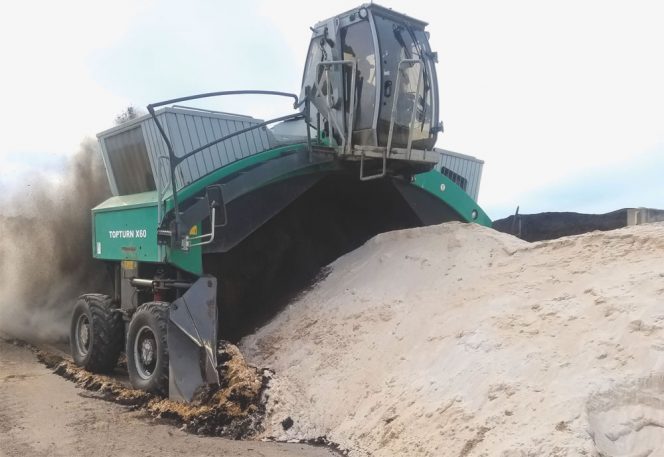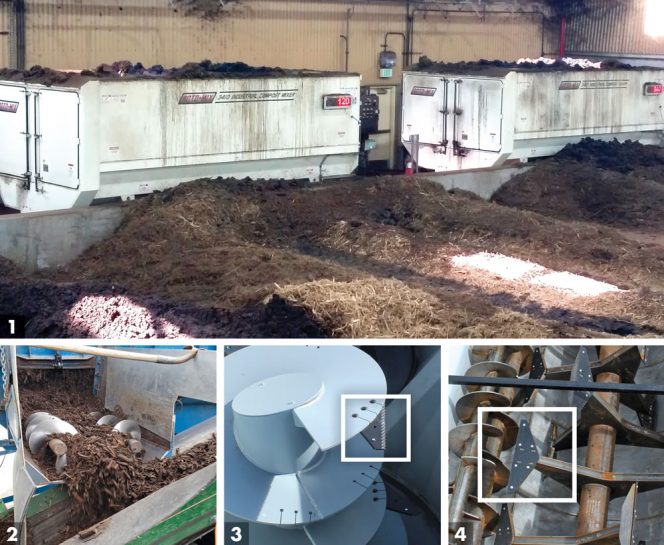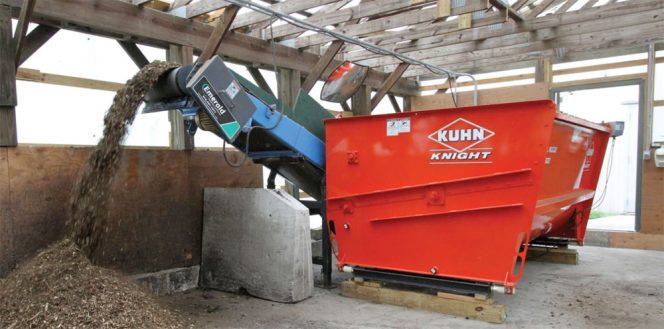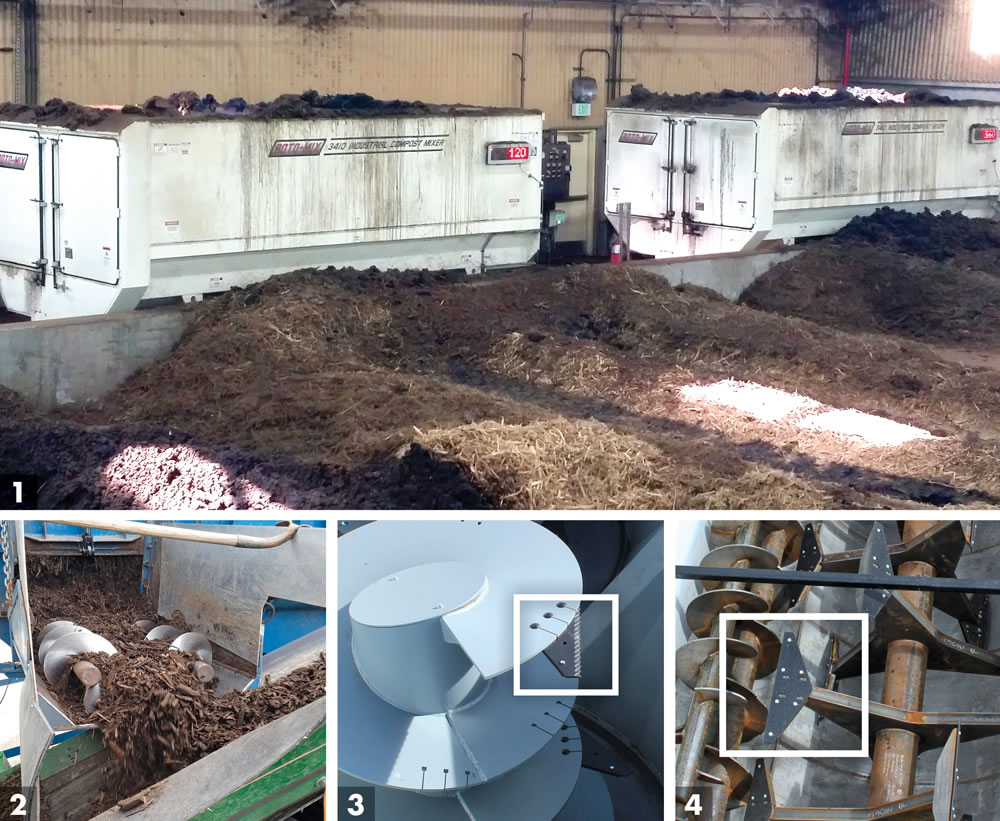Mixing balances C:N ratios, distributes moisture more evenly, reduces particle sizes and homogenizes feedstocks — all key to getting composting off on the right foot.
Craig Coker
 The unit operation known as mixing, in which two or more materials are interspersed with one another, is one of the oldest yet least understood unit operations in process engineering. The mixing process at composting facilities is used to balance carbon-nitrogen ratios, distribute moisture more evenly, reduce particle sizes, and homogenize feedstocks to facilitate optimal composting. Mixing is done at every scale of composting, from backyard bins handling kitchen scraps to large industrial-scale facilities handling multiple feedstocks. Composting schools frequently draw the analogy between composting and baking when it comes to composting recipes, but that analogy is also apropos for mixing. Poor mixing results in less than optimal composting.
The unit operation known as mixing, in which two or more materials are interspersed with one another, is one of the oldest yet least understood unit operations in process engineering. The mixing process at composting facilities is used to balance carbon-nitrogen ratios, distribute moisture more evenly, reduce particle sizes, and homogenize feedstocks to facilitate optimal composting. Mixing is done at every scale of composting, from backyard bins handling kitchen scraps to large industrial-scale facilities handling multiple feedstocks. Composting schools frequently draw the analogy between composting and baking when it comes to composting recipes, but that analogy is also apropos for mixing. Poor mixing results in less than optimal composting.
Mixing requires the motion of materials in order to reach the desired level of uniform distribution in the mix (the property is known as homogeneity). It is accomplished by the motion of particles within the overall mass of materials being mixed. Mixtures of liquids can be achieved by simply adding them together in a container; diffusion of the particles mixes the ingredients (although stirring speeds mixing). Mixtures of solids can require significant amounts of external energy to move the particles around within the mixture mass to achieve homogeneity. This external energy is usually delivered by an electric or diesel-powered motor turning one, or more, agitation devices such as paddles, screws and augers. Most mixing systems operate as batch mixers due to their greater flexibility and lower installation costs compared to continuous processes.
Mixing Methods
Early stage composting facilities often mix feedstocks using a method called “bucket-blending,” where different feedstocks are layered over each other in a pile, with each layer being about 6-inches to 8-inches thick. The operator of a rubber-tired or tracked front-end loader uses the bucket to pick up a cross-section of this “layer cake,” lifting the bucket to its maximum height and then rolling the bucket forward to let the contents spill out onto the ground, mixing as they fall. The process is then repeated 4 to 5 times to achieve a well blended mix. This approach works well for mixing varied organic solid wastes like grass clippings, leaves and ground brush, or food wastes with well ground yard trimmings, but given that the capacities of loader buckets are often less than 6 cubic yards (cy), bucket-blending can be a time-consuming and expensive method of mixing.

Royal Oak Farm in Virginia utilizes a windrow turner to mix soil, sand and compost to create custom soil blends. Photo courtesy of Royal Oak Farm
Windrow composting facilities often use their windrow turners as mixers, both for initial feedstock mixing and for customized soil blending. “We pile our feedstocks into a 7-foot tall by 14-foot wide layer cake and then run our Komptech windrow turner through it twice to get a really good mix,” explains Ken Newman, Managing Member of Royal Oak Farm LLC, a 75,000 tons/year windrow composting operation in Virginia. “We typically use our Backhus turner to make soil blends in the same way. It gives us a really good mix with only two passes.” One drawback when mixing food wastes is that round fruits and vegetables will tend to roll out of the windrows to the side by the action of the turner drum.
Composting facilities seeking to reduce mixing costs, those mixing wet and heavy materials (like biosolids) or those using forced aerated static pile (ASP) composting often use mechanical mixers. With ASP composting it is very important to have a good mix given the usual lack of turning in ASP systems (see “Aeration Floor Fundamentals,” June 2017). Almost all of the biosolids composting facilities use mechanical mixers as it is important to get the biosolids evenly distributed around each of the woody carbon amendment pieces in the mix. Mechanical mixing of biosolids works best when the material is in the 18 to 25 percent total solids range. If the consistency is too soupy, the biosolids will drain to the bottom of the mixer and not mix well. Conversely, if the biosolids are too dry, it is hard to get a coating around each wood chip, plus the biosolids tend to form small balls and not get mixed.
Mechanical mixers can be configured either horizontally or vertically. “Horizontal mixers are better if the materials being mixed have already been reduced to final particle size, whereas vertical mixers are better for size reduction, as cutting blades can be fastened to the vertical flights,” notes Wally Stimpert, Manager of Distributor and Industrial/Government Sales for Roto-Mix, Inc., a large mixer technology company.
Case Studies

Stationary mixers installed at biosolids composting facility (1). Mechanical mixers evenly spread biosolids around each of the woody carbon bulking agent amendments (2). Cutting blades on Roto-Mix’s vertical flights help reduce size of feedstocks, e.g, whole fruits and cardboard (3). Supplemental offset paddle stirrer (4). Photos courtesy of Roto-Mix, Inc., City of Sedalia, MO
Missoula, Montana
The City of Missoula owns and operates Garden City Compost, a 78,500 cy/year extended ASP biosolids and green waste composting facility next to its wastewater treatment plant (purchased from EKO Compost in 2016). The operation used to bucket-blend the feedstocks to mix, then switched to using a windrow turner. “We tried to use the turner, although the volume of biosolids and green waste we needed to mix correctly was too large for the machine we were using, and it took more space and time than we had available,” explains Jason Duffin, Garden City Compost Supervisor. “Also, the wetter biosolids would stay more in the middle and the lighter fluffier green waste organics would be on the outer edge.”
The City purchased a Roto-Mix 3410 horizontal mechanical mixer in July 2017. “The acquisition of the Roto-Mix has improved things here greatly,” Duffin adds. “A pile that took 20 minutes to build and fluff takes only 8 to 12 minutes. And the reason it even takes that long is the front-end loader has to move the material to the mixer. The consistency of the mix is much more thorough and we have no concerns about pockets that aren’t mixed in anymore.” In addition to the screw augers in the horizontal mixer, Missoula’s unit has ancillary paddles that help stir the mix and feed it towards the mixing augers.
Because the city handles a lot of abrasive land-clearing debris in its green waste stream, Duffin decided to purchase a second set of augers and have them made from abrasion-resistant (AR) steel. The plan is to swap out the first set before they are worn, and replace the flights with AR steel. Duffin estimates the cost of mixing at $4.45/ton to run a single 28-cy batch, noting that the mixing process reduces the batch volume to 25 cy, or a unit cost of $0.18/cy to mix.
Sedalia, Missouri
The City of Sedalia owns and operates a 15,000 tons/year biosolids composting facility using ASP composting technology provided by Engineered Compost Systems. The ECS package included a LuckNow Mixer from Helm Welding. Dan McCarthy, the Compost Plant Manager, explains how the system works: “We have a stationary unit, powered by a three-phase 40-horsepower motor. We grind wood chips to a 3-inch minus size and load them into the mixer, followed by the dewatered biosolids. We also add in grass clippings in the summer. The mixer has proven to be very reliable and we are very happy with the blend we get out of the mixer.”
Goldsboro, North Carolina
The City of Goldsboro built an agitated bed composting facility in 2001, sized for 12,500 tons of biosolids and 12,000 tons of yard trimmings annually. It currently has 3 Roto-Mix 620-16 Industrial Compost Series Mixers mounted on trucks. The composting facility is located a short distance from the wastewater treatment plant. To mix feedstocks, the operators load yard trimmings into the Roto-Mix truck, which drives over to the treatment plant to get biosolids. Mixing occurs as the biosolids are loaded into the truck. In this example, the mixing truck serves as a feedstock transport vehicle and as a mixing machine.

The Marcellus (NY) aerated static pile composting facility uses a KUHN Knight Reel® Auggie® to mix biosolids
and wood chips. Photo courtesy of KUHN Knight
Marcellus, New York
The Village of Marcellus constructed an ASP biosolids composting facility that began operating in 2012. Anaerobically digested biosolids (16-18% solids) are mixed with wood chips in a KUHN Knight Reel® Auggie® mixer. The large reel turns slowly, lifting material up and into two blending augers. The lower auger moves material forward and serves as the discharge auger while the upper auger moves material rearward for load leveling. The feedstock mix is placed on perforated plastic drainage pipe and covered with wood chips, composted for 21 days, then moved to a curing pile without aeration. Finished compost is screened and provided to residents.
Craig Coker is a Senior Editor at BioCycle and CEO of Coker Composting & Consulting near Roanoke, VA. He can be reached at ccoker@jgpress.com.










